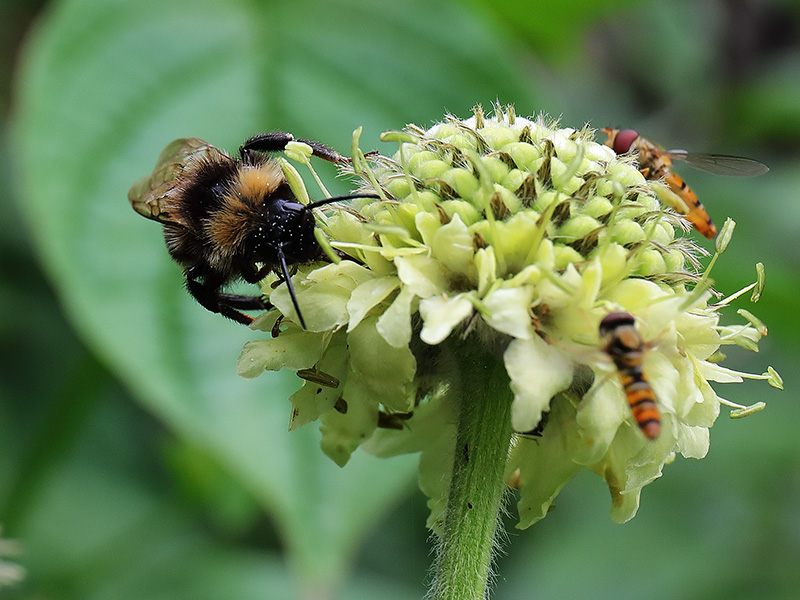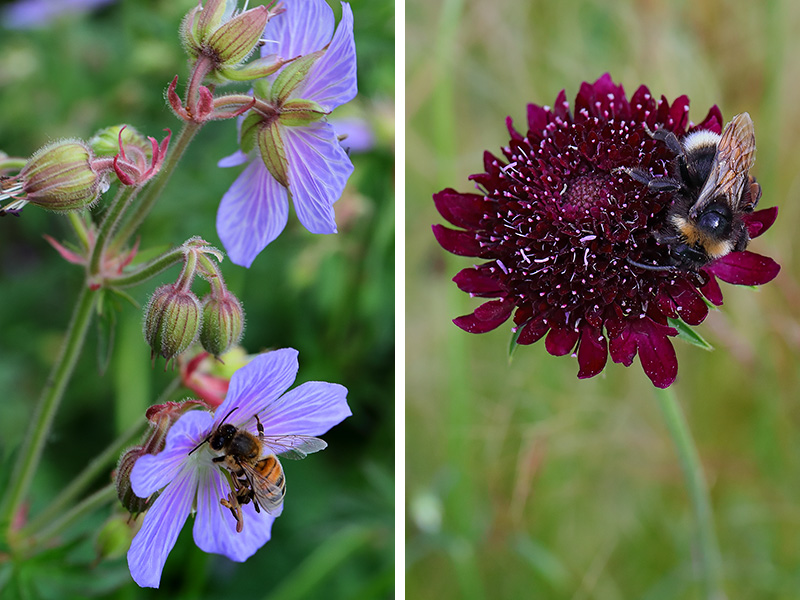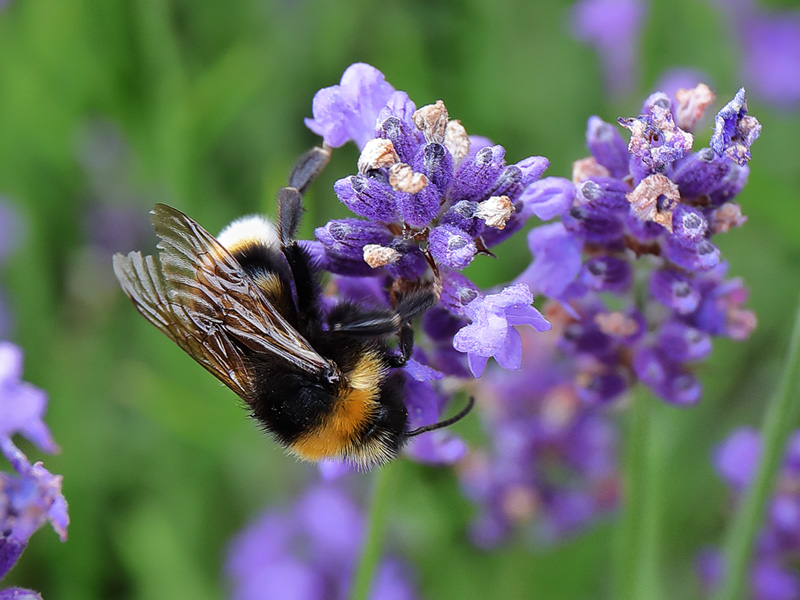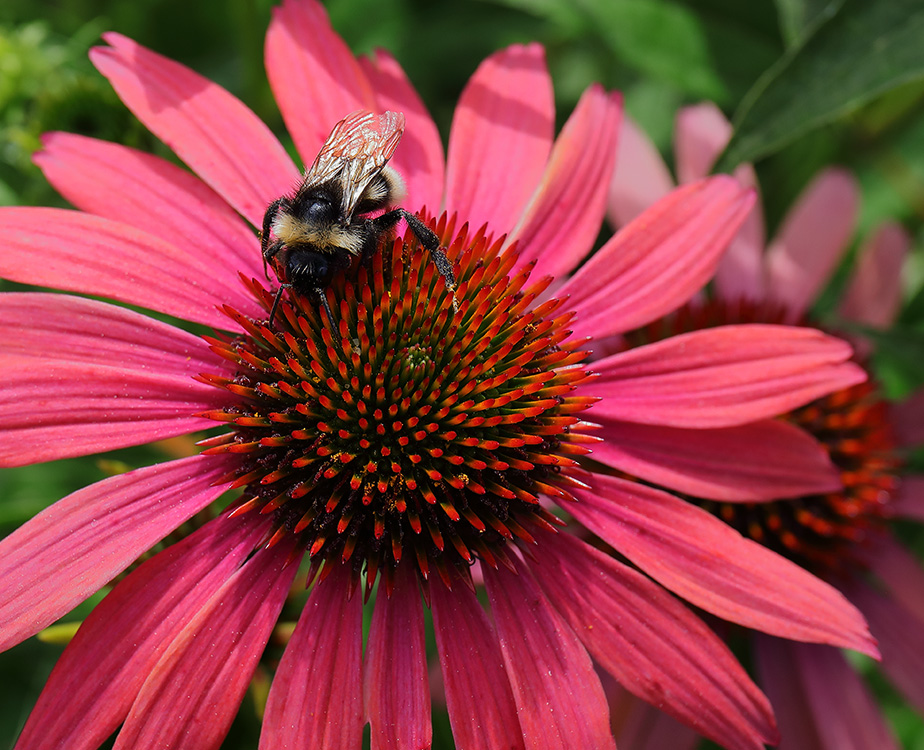The summer feels like it’s going by too quickly. (As always!) Already the flowers that I associate with late summer are starting to make an appearance. I’ve noticed the first pale pink flowers to open on my patch of Japanese anemones, and the echinacea plants (above) are now beginning to display their brightly-coloured daisies.
There are lots of flowers in the garden at the moment so there are also plenty of bees and hoverflies around. That’s very appropriate because this week has been the annual ‘Bees’ Needs Week’ in the UK. This is a campaign to encourage us to grow suitable plants for bees and pollinators and to allow areas in our gardens to be wild enough to create a habitat for them.

Interest in helping bees (and wildlife in general) has grown greatly in recent years, with many gardeners delighted to provide spaces for nature. Now local councils and other bodies are taking a more sympathetic stance too. They have been allowing areas of grass to remain uncut for longer and even encouraging wild patches and mini meadows in previously manicured areas.
It’s good to see the bees back again here after a couple of weeks that have been unusually wet and much cooler than normal. Certain flowers are particularly successful at attracting bees. Here it’s the various members of the scabious family that seem to always have bees and hoverflies around them.
The pale yellow flowers of the giant scabious (Cephalaria gigantea, above) are a recent addition to the garden and have proved very popular. Their impressive height makes it a little difficult for me to photograph the bees on them though! (They can get up to 8 ft. tall, but mine have still some way to go.) Scabiosa atropurpurea (below, right) is up to about 3 ft. tall, so much easier to photograph!

The blue geranium pictured on the left (‘Mrs. Kendall Clark’) has finished flowering but geranium ‘Rozanne’ is ready to take over its role. However, although the bees enjoy it, there weren’t any on its flowers when I took my photographs.
I think the bees weren’t interested in the flowers of Rozanne because the lavender beside it was in full flower and more alluring. I watched lots of these buff-tailed bumblebees (below) buzzing from flower to flower, clearly intent on making the most of the nectar in the tiny flowers before they all go over. (Bumblebees have longer tongues than honeybees, which makes it easier and quicker for them to access the nectar in lavender than it is for honeybees. This means they tend to move around the flowers quite fast – so harder work for the photographer!)
Given how much the bees enjoy the lavender, I’ll plant more of it for next summer. (Angustifolia varieties are reckoned to be particularly good.) I’m very happy to be able to provide something for the bees here. It seems only fair when I enjoy going on a ‘bee-hunt’ with my camera – and of course, we need our bees!


Lovely to see the different flowers and I especially love the colour of the echinacea!
LikeLiked by 1 person
I see some tiny echinacea seedlings nearby – wonder if they’ll come up the same colour? I hope so! 🙂
LikeLiked by 1 person
It’s always good to see the bees around. This year we have seen more honey bees than in the past, at least it seems so, and we are having a great blueberry crop as a result. The vegetable garden, which also hosts flowers, is doing quite well also. The milkweed crop, which draws bees and many other pollinators, was robust but has now faded, partly due to the heat spells, and is not drawing much attention. Good year for all our flower visitors.
LikeLiked by 1 person
We have mostly bumblebees this year, with fewer honeybees at the moment. I think that probably depends what’s in flower at the time. There were plenty of honeybees coming to the ceanothus earlier in the year. It’s great that you’re having a good year for the little visitors! 🙂
LikeLiked by 1 person
Wonderful pictures, Ann! Excellent macros with a lot of details!
LikeLiked by 1 person
Thank you Indira! I enjoy trying to photograph the bees and other little ones – it probably helps make my reflexes a little faster too!
LikeLiked by 1 person
Lovely flowers and photos (and bees). My Mrs Kendall Clark is still flowering and Rozanne is going mad this year. I really need to cut it back, but it is still flowering and covered in bees.
LikeLiked by 1 person
My Rozanne is going mad too, so I’m hoping to be able to split it and get it going somewhere else. 🙂
LikeLiked by 1 person
These are beautiful photographs. We, too, have a few more bees this year…the native plant commonly referred to as “Mountain Mint” is in “flower” here in Virginia although the blooms are not that prominent but they are loved by bees.
LikeLiked by 1 person
Great pix Ann! Those bee images are really sharp. How can you tell whether a bee is a honey bee or a bumble bee other than the speed they access the nectar? I have some bees that inundate the blossoms in my front yard but not sure what I am looking at. They are not really pretty one like your bees.
LikeLiked by 1 person
They do look different – bumblebees are fluffy looking but the hairs on our honeybees are very much shorter. The stripes on bumbles are distinctive too. You can see the honeybee we get here (Apis mellifera) in the top pic of this post: https://annmackay.blog/2021/05/23/buzz-buzz-bee-lated-celebrations/ But there are lots of other kinds of bee too! (And I can’t tell them apart – yet!)
LikeLiked by 1 person
It’s very difficult to photograph bees, at least I find it tricky. You’ve got a lot of lovely bee plants there, it’s so important to attract pollinators. They have been visiting my lavender and purple loosestrife.
LikeLiked by 1 person
Planting to attract bees etc. has given a sense of purpose to my gardening and I’m enjoying it. It feels like just the tiniest of ways of making a difference. And I get to try to photograph the bees – it IS difficult at times! Lavender and purple loosestrife are great bee plants – I should plant the loosestrife here. 🙂
LikeLiked by 1 person
My loosestrife plants itself and in the weirdest places. I remember you promoting bees needs week last year, and what a year we’ve had. Life might have been easier as a bee.
LikeLiked by 1 person
LOL, plants do stick themselves in very odd places! Sometimes they get it right though. 🙂 At least bees don’t have to worry about social distancing…there’s a festival on in Suffolk (Latitude) which is being monitored as an experiment so I’m dreading the probable Covid rise locally.
LikeLiked by 1 person
I found one of our native prairie remnants covered in rattlesnake master (Eryngium yuccifolium) last weekend, and the ball-shaped flower heads were covered in bees, wasps, ants, and dragonflies. The section of the prairie where they were growing was burned a year or two ago, and that no doubt allowed them to emerge. I need to find a photo to share with Tony; I thought about the plant when I read his post about the connection between fragrance and white flowers. I’ve never encountered such perfume anywhere; the flowers aren’t as striking as those you’ve shown here, but they make up for it with scent.
LikeLiked by 1 person
That is such a hopeful sight – that they could come back after the fire. And the sight of all those feeding insects and the scent must have been really wonderful. 🙂
LikeLike
I should have said “prescribed fire.” The whole point of fire in prairie management is to clear out the invasives so that the natives come back. In this case, they certainly did. What’s fun is that there’s often no predicting what will show up after a burn. Plants that have lain dormant for years beneath dense ground cover respond so well to having increased sunlight.
LikeLiked by 1 person
Ah, that puts a different slant on it! It must be really interesting to see what plants will come up, especially if folk have forgotten that particular plants were ever there… 🙂
LikeLike
Lovely 🌹
LikeLiked by 1 person
Thank you Priti! 🙂
LikeLike
🤗🤗💓
LikeLiked by 1 person